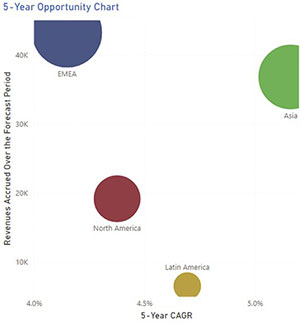

The Hydrogen Electrolyzers Emerging Market Analysis delivers current market analysis plus a five year market and technology forecast. The research covers Hydrogen Electrolyzers, Renewable Energy, Green Hydrogen, Gray Hydrogen, Alkaline, Solid Oxide, Proton Exchange Membrane, PEM, Strategic Analysis, Market Size, Industry Trends
According to ARC Advisory Group research, the market for hydrogen electrolyzers is ready for significant growth as the market shift to renewable energy intensifies. ARC’s research provides an insightful analysis of the emerging market for the manufacture and sales of commercial off-the-shelf dedicated hydrogen electrolyzers. This research focuses on the market for dedicated hydrogen electrolyzer systems and excludes electrolyzers for chlor-alkali processes which produce hydrogen as a byproduct. This research includes information on market size, growth, and key trends.
 In addition to providing a five-year market forecast, the Hydrogen Electrolyzers market research provides detailed quantitative current market data and addresses key strategic issues as follows.
In addition to providing a five-year market forecast, the Hydrogen Electrolyzers market research provides detailed quantitative current market data and addresses key strategic issues as follows.
If you are looking at electrolyzers, it is highly likely that you have a requirement for green hydrogen, otherwise grey hydrogen would be much cheaper until the price of green power drops substantially. Find a low-cost reliable source of green power with a power purchase agreement and sufficient electrolyzer efficiency that allows you to produce hydrogen at a favorable cost considering maintenance, equipment life, and ultimate equipment recycling/disposal. There are three main technologies available on the market: alkaline, solid oxide, and proton exchange membrane (PEM) electrolyzers. Alkaline electrolyzers are cheaper in terms of investment (they use nickel catalysts) but are least efficient. PEM electrolyzers are more expensive (they generally use expensive platinum and iridium metal catalysts available in South Africa, Zimbabwe, and the Russia) but are more efficient and can operate at higher current densities, and can, therefore, be possibly cheaper if the hydrogen production is large enough. These same rare earth metals are used in fuel cells. Solid oxide electrolyzer cells (SOEC) are the third most common type of electrolysis and use high operating temperatures to increase efficiency. The theoretical electrical efficiency of SOEC is close to 100 percent.
The stack cost of an alkaline electrolyzer is lower than PEM. But when it comes to the complexity and cost of balance of plant (BOP) as the system size increases, PEM is lower, according to the Fraunhofer Institute for Solar Energy Systems ISE. In fact, the total cost of ownership of a PEM electrolyzer is lower than alkaline with forecasters estimating that PEM service costs are one-third of alkaline. SOECs are also an emerging technology for electrolyzers that have been built at demonstration scale. Anion exchange membrane (AEM) electrolysis is still in the early research and development stage, while alkaline water electrolysis is in the mature stage and PEM electrolysis is in the commercial stage. The major technical challenge facing a consumer level AEM electrolyzer is the low durability of the membrane.
ALK electrolyzers’ caustic electrolyte solution can also ratchet up its hefty price tag. For example, a 10 to 20-year project means a long term need to replace parts such as pumps and valves, or the removal of potassium hydroxide from the hydrogen or oxygen streams. The 3.5 ton per megawatt requirement for highly-corrosive potassium hydroxide in alkaline systems typically incur significant space requirements–often two to three times the space of a PEM system for a similar output. Any losses in space can lead to losses in revenue. When considering output pressure, standard alkaline electrolyzers deliver output at a low pressure of 1 to 10 bar, which is nearly ambient pressure. For most applications, hydrogen must be further compressed for transport, storage, or consumption. PEM electrolyzers have an output of 40 bar—that is 4 to 40 times of a typical alkaline system. PEM reduces the cost of compression.
Find a reliable customer for the hydrogen that is produced. Many early projects with green hydrogen are development projects to prove the concept. The new markets for hydrogen depend on regulations such as a price on carbon, penalties for greenhouse gas emissions, or other incentives that will make them economic. Currently refining, steel, cement kilns, and ammonia industries have little economic incentive to switch to green hydrogen. There may be corporate commitments to sustainability, net zero, or carbon reduction goals, but these come at a price. Grey hydrogen is cheaper than green hydrogen and easy to produce. Vehicle filling stations are certainly a requirement for a green hydrogen transportation system just as EV chargers are needed for EVs. Supplying hydrogen filling station with grey hydrogen would increase total CO2 emissions compared to just using gasoline or diesel cars or trucks, negating the appeal of hydrogen. As green hydrogen is very expensive today, hydrogen car makers have offered rebates. Toyota Mirai comes with $15,000 or 6 years, whichever comes first, of complimentary hydrogen fuel purchases. Early Tesla EV’s came with lifetime free supercharging. After these free hydrogen incentives are discontinued the cost of fuel for hydrogen will be much higher than the cost of electricity for EVs.
This market research may be purchased as a MIRA Service, an Excel Workbook, and/or as a Market Analysis Report (PDF). MIRA Services help unlock the full benefits of ARC’s market intelligence, making the data more actionable for you by adding qualitative context to our market data in an online environment unique to each customer. Regional editions include country and industry market data. Formats available are listed below:
| MIRA Service | MIRA Workbook | Market Analysis PDF | |
| Worldwide (includes regional data) | Yes | Yes | Yes |
| Annual Subscription | Yes | No | No |
The research identifies all relevant suppliers serving this market.
For more information or to purchase the Hydrogen Electrolyzer Market Research, please contact us.
Learn more about ARC In-depth Research at Market Analysis
Learn more about ARC Strategic Services at Advisory Services for Industry Leaders

